Bozena Kostek
Computer-assisted Pronunciation Training -- Speech synthesis is almost all you need
Jul 02, 2022
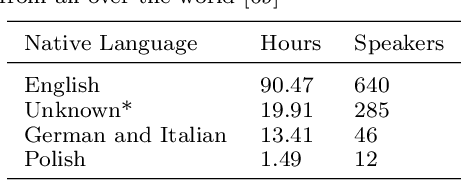


Abstract:The research community has long studied computer-assisted pronunciation training (CAPT) methods in non-native speech. Researchers focused on studying various model architectures, such as Bayesian networks and deep learning methods, as well as on the analysis of different representations of the speech signal. Despite significant progress in recent years, existing CAPT methods are not able to detect pronunciation errors with high accuracy (only 60\% precision at 40\%-80\% recall). One of the key problems is the low availability of mispronounced speech that is needed for the reliable training of pronunciation error detection models. If we had a generative model that could mimic non-native speech and produce any amount of training data, then the task of detecting pronunciation errors would be much easier. We present three innovative techniques based on phoneme-to-phoneme (P2P), text-to-speech (T2S), and speech-to-speech (S2S) conversion to generate correctly pronounced and mispronounced synthetic speech. We show that these techniques not only improve the accuracy of three machine learning models for detecting pronunciation errors but also help establish a new state-of-the-art in the field. Earlier studies have used simple speech generation techniques such as P2P conversion, but only as an additional mechanism to improve the accuracy of pronunciation error detection. We, on the other hand, consider speech generation to be the first-class method of detecting pronunciation errors. The effectiveness of these techniques is assessed in the tasks of detecting pronunciation and lexical stress errors. Non-native English speech corpora of German, Italian, and Polish speakers are used in the evaluations. The best proposed S2S technique improves the accuracy of detecting pronunciation errors in AUC metric by 41\% from 0.528 to 0.749 compared to the state-of-the-art approach.
Weakly-supervised word-level pronunciation error detection in non-native English speech
Jun 07, 2021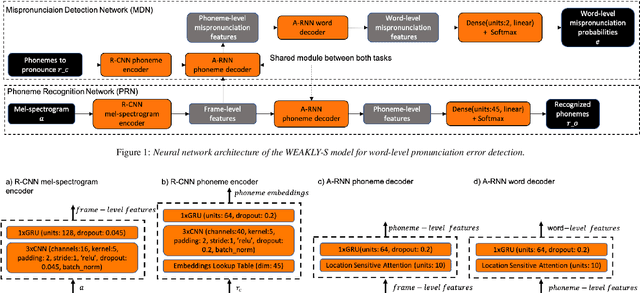
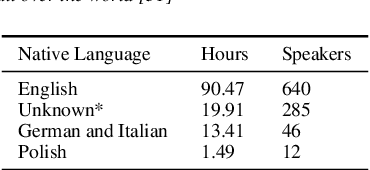


Abstract:We propose a weakly-supervised model for word-level mispronunciation detection in non-native (L2) English speech. To train this model, phonetically transcribed L2 speech is not required and we only need to mark mispronounced words. The lack of phonetic transcriptions for L2 speech means that the model has to learn only from a weak signal of word-level mispronunciations. Because of that and due to the limited amount of mispronounced L2 speech, the model is more likely to overfit. To limit this risk, we train it in a multi-task setup. In the first task, we estimate the probabilities of word-level mispronunciation. For the second task, we use a phoneme recognizer trained on phonetically transcribed L1 speech that is easily accessible and can be automatically annotated. Compared to state-of-the-art approaches, we improve the accuracy of detecting word-level pronunciation errors in AUC metric by 30% on the GUT Isle Corpus of L2 Polish speakers, and by 21.5% on the Isle Corpus of L2 German and Italian speakers.
Mispronunciation Detection in Non-native (L2) English with Uncertainty Modeling
Feb 08, 2021
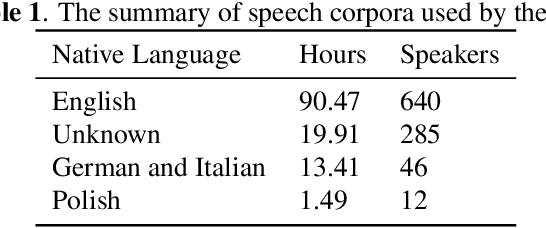

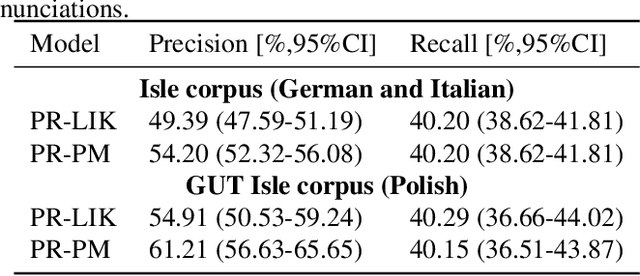
Abstract:A common approach to the automatic detection of mispronunciation in language learning is to recognize the phonemes produced by a student and compare it to the expected pronunciation of a native speaker. This approach makes two simplifying assumptions: a) phonemes can be recognized from speech with high accuracy, b) there is a single correct way for a sentence to be pronounced. These assumptions do not always hold, which can result in a significant amount of false mispronunciation alarms. We propose a novel approach to overcome this problem based on two principles: a) taking into account uncertainty in the automatic phoneme recognition step, b) accounting for the fact that there may be multiple valid pronunciations. We evaluate the model on non-native (L2) English speech of German, Italian and Polish speakers, where it is shown to increase the precision of detecting mispronunciations by up to 18% (relative) compared to the common approach.
Detection of Lexical Stress Errors in Non-native English with Data Augmentation and Attention
Dec 29, 2020
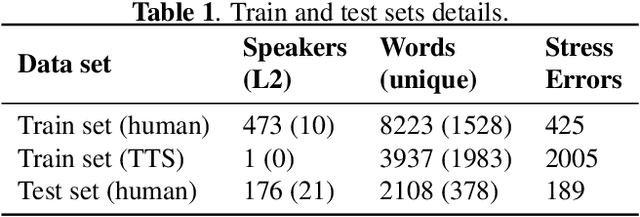
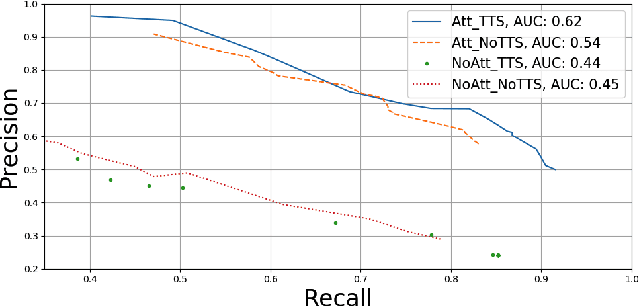

Abstract:This paper describes two novel complementary techniques that improve the detection of lexical stress errors in non-native (L2) English speech: attention-based feature extraction and data augmentation based on Neural Text-To-Speech (TTS). In a classical approach, audio features are usually extracted from fixed regions of speech such as syllable nucleus. We propose an attention-based deep learning model that automatically derives optimal syllable-level representation from frame-level and phoneme-level audio features. Training this model is challenging because of the limited amount of incorrect stress patterns. To solve this problem, we propose to augment the training set with incorrectly stressed words generated with Neural TTS. Combining both techniques achieves 94.8\% precision and 49.2\% recall for the detection of incorrectly stressed words in L2 English speech of Slavic speakers.
Interpretable Deep Learning Model for the Detection and Reconstruction of Dysarthric Speech
Jul 10, 2019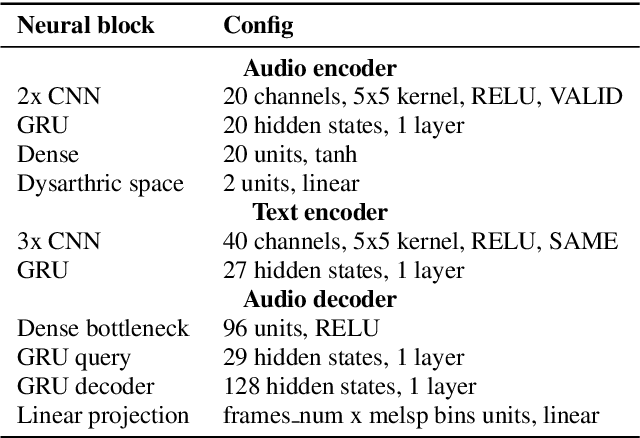
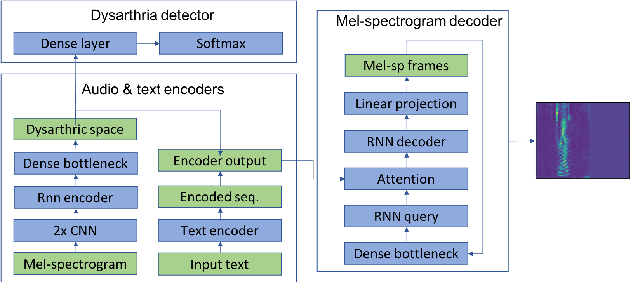
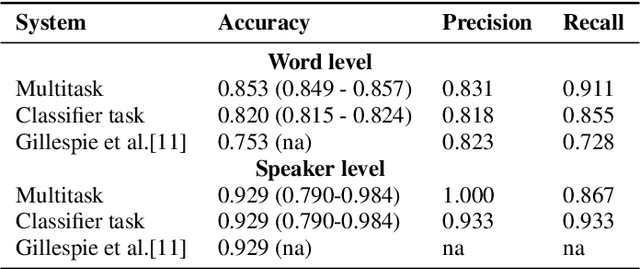

Abstract:This paper proposed a novel approach for the detection and reconstruction of dysarthric speech. The encoder-decoder model factorizes speech into a low-dimensional latent space and encoding of the input text. We showed that the latent space conveys interpretable characteristics of dysarthria, such as intelligibility and fluency of speech. MUSHRA perceptual test demonstrated that the adaptation of the latent space let the model generate speech of improved fluency. The multi-task supervised approach for predicting both the probability of dysarthric speech and the mel-spectrogram helps improve the detection of dysarthria with higher accuracy. This is thanks to a low-dimensional latent space of the auto-encoder as opposed to directly predicting dysarthria from a highly dimensional mel-spectrogram.
 Add to Chrome
Add to Chrome Add to Firefox
Add to Firefox Add to Edge
Add to Edge